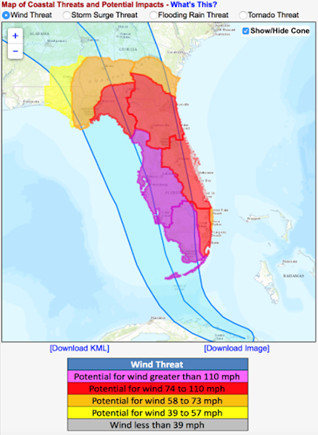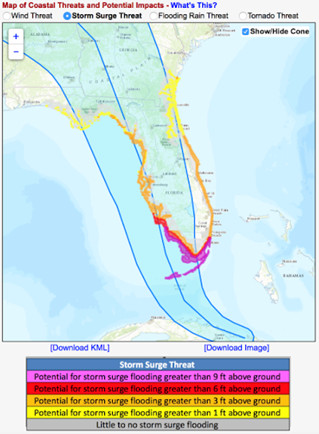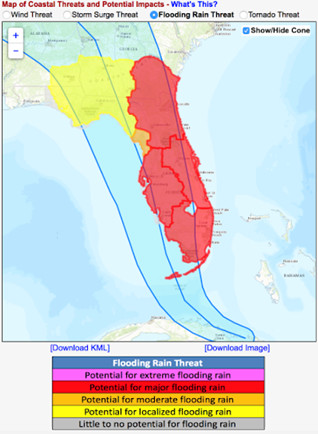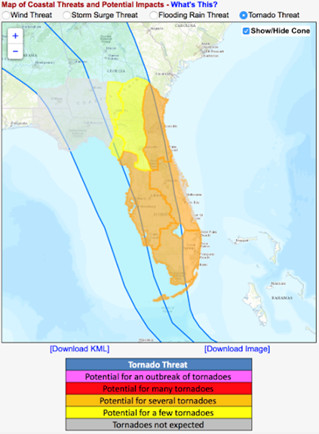Navigating hurricane season can be stressful, especially when planning a trip or living in coastal areas. As gaymexico.net, we understand the need for reliable and updated information, especially for the LGBTQ+ community and allies planning travel to Mexico. Our guide helps you stay informed and safe, ensuring your experiences in Mexico remain enjoyable, even during challenging weather. With our comprehensive insights and resources, you’ll navigate weather concerns confidently.
1. Understanding Hurricane Threats in the Gulf of Mexico
Hurricanes in the Gulf of Mexico pose significant threats to both residents and tourists. These powerful storms can bring destructive winds, storm surges, flooding rain, and even tornadoes. Understanding these threats is crucial for preparing and staying safe.
1.1. What are Hurricane Threats and Impacts (HTI) Graphics?
Hurricane Threats and Impacts (HTI) graphics are visual tools created by local Weather Forecast Offices (WFOs) to communicate the potential hazards associated with tropical cyclones. These graphics are issued when tropical cyclone wind watches and warnings, and/or storm surge watches and warnings, are in effect for at least part of their land area of responsibility. The HTI graphics are updated with each new forecast issued by the National Hurricane Center (NHC) or Central Pacific Hurricane Center (CPHC) and maintained until the threats have locally passed.
 Wind Threat
Wind Threat
This graphic illustrates the potential wind threats associated with a hurricane, showing areas that could experience winds greater than 110 mph.
1.2. How HTI Graphics Enhance Safety
HTI graphics go beyond the typical hurricane cone, which only shows the most probable track of the storm’s center. Instead, HTI graphics illustrate the geographic extent of associated hazards, their level of threat, and potential impacts. This comprehensive approach allows for more effective preparedness actions. According to the National Weather Service, HTI graphics use a color-coded scale to represent increasing levels of threat, ranging from warm to hot colors.
1.3. Hazards Described by HTI Graphics
The HTI graphics suite addresses four primary hazards:
- Tropical Wind: Potential for damaging winds.
- Storm Surge: Coastal inundation from rising water levels.
- Flooding Rain: Heavy rainfall leading to flash floods.
- Tornadoes: Spawning of tornadoes within the storm system.
 Surge Threat
Surge Threat
This graphic shows the potential storm surge threat, indicating areas that may experience coastal flooding.
2. Accessing and Interpreting HTI Graphics
Knowing how to access and interpret HTI graphics can significantly improve your ability to prepare for a hurricane. These graphics provide detailed information about potential conditions and impacts, helping you make informed decisions.
2.1. How to Access HTI Graphics
You can access the HTI Graphics suite through the following web portal: weather.gov/srh/tropical. Additionally, most coastal WFO websites provide links to HTI graphics during active hurricane or tropical storm events.
2.2. Navigating the Tropical Web Portal
When you reach the tropical web portal, you will see tabs across the top of the page. Click on the “Threats and Impacts” tab to display HTI information. By default, the wind hazard is initially displayed, but you can select any of the radio buttons to retrieve information on other hazards of interest.
2.3. Understanding the Graphical Information
The HTI graphics provide several key pieces of information:
- Threat Map: Displays the corresponding threat map as assessed by the local WFO. A color-coded legend unique to each hazard is also provided.
- Location-Specific Forecast: Click on a map location to obtain current information on that hazard for the desired site and its vicinity. Information is extracted from local text products and displayed to the right of the map.
- Potential Impacts: By clicking on a map location, users also obtain descriptions of potential impacts. These are the resulting impacts which would likely occur if the hazard were realized to its graphically depicted potential.
 FloodingRain Threat
FloodingRain Threat
This graphic illustrates the potential for flooding rain, highlighting areas that may experience heavy rainfall and flash floods.
2.4. Key Considerations When Interpreting HTI Graphics
Remember that the map is not a forecast map for the selected hazard. Rather, it is a depiction of the forecast with a safety margin included. Consequently, text information that describes the latest forecast (without accounting for forecast error) on the right of the map may or may not match the map on the left (which does account for forecast error). The HTI is designed to help make preparedness actions more effective. For additional information about hurricane preparedness, please see ready.gov/hurricanes and always follow the recommended actions of local officials during an event.
3. Real-Time Hurricane Tracking and Updates
Staying informed about the current status of hurricanes in the Gulf of Mexico is crucial for safety and preparedness. Several reliable resources provide real-time tracking and updates.
3.1. National Hurricane Center (NHC)
The National Hurricane Center (NHC) is the go-to source for official hurricane information. The NHC provides forecasts, warnings, and analyses of tropical weather. According to the NHC, their website offers detailed maps, satellite images, and forecast discussions.
3.2. National Weather Service (NWS)
The National Weather Service (NWS) provides local weather forecasts and warnings. Their website allows you to search for your specific location and receive up-to-date information on any active hurricanes. The NWS also offers mobile apps for on-the-go access to weather information.
3.3. Reliable Weather Apps and Websites
Several weather apps and websites offer hurricane tracking and updates, including:
- The Weather Channel: Provides detailed forecasts, radar images, and hurricane tracking tools.
- AccuWeather: Offers real-time weather updates, including hurricane tracking and alerts.
- Storm Shield: Sends weather alerts based on your location, including hurricane warnings.
3.4. Monitoring Social Media and News Outlets
Social media platforms like Twitter and Facebook can provide real-time updates from official sources and local news outlets. Following official accounts can help you stay informed about the latest developments.
4. Hurricane Preparedness Tips for LGBTQ+ Travelers to Mexico
Preparing for a hurricane involves several key steps to ensure your safety and well-being. These tips are tailored for LGBTQ+ travelers to Mexico, keeping in mind unique needs and considerations.
4.1. Before the Hurricane
- Create an Emergency Kit: Gather essential supplies like water, non-perishable food, medications, and a flashlight.
- Stay Informed: Monitor weather forecasts and heed warnings from local authorities.
- Plan Your Evacuation Route: Identify safe routes and destinations in case of an evacuation order.
- Secure Your Accommodation: Ensure your hotel or rental property is hurricane-resistant.
- Check Insurance Coverage: Confirm your travel insurance covers hurricane-related incidents.
According to ready.gov, an emergency kit should include at least a three-day supply of water and non-perishable food.
4.2. During the Hurricane
- Stay Indoors: Seek shelter in a sturdy building away from windows and doors.
- Monitor Weather Updates: Keep track of the storm’s progress through reliable sources.
- Conserve Resources: Ration food and water, and use electricity sparingly.
- Stay Connected: Maintain communication with family and friends if possible.
- Follow Official Instructions: Comply with evacuation orders and safety guidelines.
 Tornado Threat
Tornado Threat
This graphic indicates the potential for tornadoes, which can occur within hurricane systems.
4.3. After the Hurricane
- Assess the Damage: Check your accommodation for structural damage and hazards.
- Avoid Floodwaters: Be cautious of contaminated water and hidden dangers.
- Report Damage: Notify local authorities or your insurance company of any losses.
- Stay Informed: Continue monitoring weather updates and safety advisories.
- Seek Assistance: Contact local support organizations for help and resources.
4.4. Specific Considerations for LGBTQ+ Travelers
- Identify LGBTQ+-Friendly Shelters: Research shelters that are inclusive and welcoming to LGBTQ+ individuals.
- Communicate Your Needs: Inform shelter staff or emergency responders of any specific needs or concerns.
- Connect with Local LGBTQ+ Organizations: Reach out to local LGBTQ+ groups for support and resources.
- Carry Identification and Important Documents: Keep copies of your passport, ID, and insurance information in a waterproof bag.
- Stay Aware of Local Laws and Customs: Understand local laws and customs regarding LGBTQ+ individuals, especially in more conservative areas.
5. Understanding Hurricane Categories and Their Impacts
Hurricanes are classified into categories based on their wind speeds, and each category has different potential impacts. Understanding these categories can help you assess the level of threat and prepare accordingly.
5.1. Saffir-Simpson Hurricane Wind Scale
The Saffir-Simpson Hurricane Wind Scale is a 1-5 scale that estimates potential property damage from a hurricane based on sustained wind speeds.
| Category | Sustained Winds (mph) | Potential Impacts |
|---|---|---|
| 1 | 74-95 | Very dangerous winds will produce some damage: Well-constructed frame homes could have damage to roof, shingles, vinyl siding and gutters. |
| 2 | 96-110 | Extremely dangerous winds will cause extensive damage: Well-constructed frame homes could sustain major roof and siding damage. |
| 3 | 111-129 | Devastating damage will occur: Well-built framed homes may incur major damage or removal of roof decking and gable ends. |
| 4 | 130-156 | Catastrophic damage will occur: Well-built framed homes can sustain severe damage with loss of most of the roof structure and/or some exterior walls. |
| 5 | 157 or higher | Catastrophic damage will occur: A high percentage of framed homes will be destroyed, with total roof failure and wall collapse. Wide-spread power outages. |
5.2. Potential Impacts by Category
- Category 1: Minimal damage to buildings, trees, and power lines.
- Category 2: Moderate damage to roofs, doors, and windows.
- Category 3: Extensive damage to small buildings and mobile homes.
- Category 4: Extreme damage to roofs, windows, and doors.
- Category 5: Catastrophic damage to most buildings, with widespread power outages.
The National Hurricane Center provides detailed descriptions of the potential impacts of each category on their website.
6. Safe Destinations in Mexico During Hurricane Season
While hurricanes can affect the Gulf of Mexico and the Caribbean, some areas in Mexico are less prone to direct hits and offer safer alternatives during hurricane season.
6.1. Pacific Coast Destinations
The Pacific coast of Mexico, including destinations like Puerto Vallarta and Acapulco, generally experiences fewer direct hits from hurricanes compared to the Gulf and Caribbean coasts.
- Puerto Vallarta: Known for its LGBTQ+-friendly atmosphere and beautiful beaches, Puerto Vallarta is a great option during hurricane season. According to a study by the UCLA Williams Institute, Puerto Vallarta has a well-established LGBTQ+ community and numerous resources for travelers.
- Acapulco: With its stunning bay and vibrant nightlife, Acapulco offers a mix of relaxation and entertainment. The city has a rich history and a variety of attractions for visitors.
Puerto Vallarta is an LGBTQ+-friendly destination on Mexico’s Pacific coast, generally safer during hurricane season.
6.2. Inland Destinations
Inland cities like Mexico City and Guadalajara are less susceptible to hurricane impacts and offer a rich cultural experience.
- Mexico City: The capital of Mexico is a bustling metropolis with world-class museums, historical sites, and a thriving LGBTQ+ scene. Mexico City’s altitude and inland location make it less vulnerable to hurricanes.
- Guadalajara: Known for its colonial architecture and tequila production, Guadalajara offers a more laid-back atmosphere than Mexico City. The city is also home to a growing LGBTQ+ community.
6.3. Yucatan Peninsula Alternatives
While the Yucatan Peninsula is prone to hurricanes, some areas are relatively safer than others.
- Campeche: This colonial city on the Gulf coast is a UNESCO World Heritage site and offers a quieter alternative to Cancun and Playa del Carmen.
- Merida: Located inland in the Yucatan Peninsula, Merida is a cultural hub with Mayan ruins, colorful markets, and a welcoming atmosphere.
7. Insurance and Travel Advisories for Hurricane Season
Travel insurance and advisories are crucial for protecting yourself and your trip during hurricane season.
7.1. Importance of Travel Insurance
Travel insurance can cover a range of hurricane-related incidents, including trip cancellations, delays, medical expenses, and lost or damaged belongings.
- Trip Cancellation Coverage: Reimburses you for non-refundable expenses if you have to cancel your trip due to a hurricane.
- Trip Interruption Coverage: Covers expenses if your trip is interrupted by a hurricane, such as additional accommodation and transportation costs.
- Medical Coverage: Provides coverage for medical expenses if you are injured during a hurricane.
- Lost or Damaged Belongings Coverage: Reimburses you for lost or damaged luggage and personal items.
7.2. Understanding Travel Advisories
Travel advisories are issued by governments to provide information about potential risks in specific destinations.
- U.S. Department of State: Provides travel advisories for Mexico, including information about hurricane season and safety recommendations.
- Canadian Government: Issues travel advisories for Mexico, offering guidance on safety and security.
- Local Authorities: Heed warnings and advisories from local authorities in Mexico, including evacuation orders and safety guidelines.
7.3. Resources for LGBTQ+ Travelers
- gaymexico.net: Offers specific advice and resources for LGBTQ+ travelers to Mexico, including information about safe destinations and LGBTQ+-friendly accommodations.
- IGLTA (International LGBTQ+ Travel Association): Provides a directory of LGBTQ+-friendly travel businesses and destinations.
- Local LGBTQ+ Organizations: Connect with local LGBTQ+ organizations in Mexico for support and resources.
8. Staying Connected and Informed During Your Trip
Maintaining communication and access to information is crucial during a hurricane.
8.1. Reliable Communication Methods
- Mobile Phones: Ensure your mobile phone is charged and has international roaming capabilities.
- Wi-Fi: Utilize Wi-Fi hotspots to access weather updates and communicate with family and friends.
- Satellite Phones: Consider bringing a satellite phone for reliable communication in remote areas.
8.2. Weather Apps and Websites
- The Weather Channel: Provides detailed forecasts, radar images, and hurricane tracking tools.
- AccuWeather: Offers real-time weather updates, including hurricane tracking and alerts.
- National Hurricane Center (NHC): The official source for hurricane information and forecasts.
8.3. Local Emergency Services
- 911: The emergency number for police, fire, and ambulance services in Mexico.
- Local Police: Contact local police for assistance and information.
- Tourist Assistance: Seek help from tourist assistance centers for guidance and support.
8.4. Social Media and News Outlets
- Twitter: Follow official accounts for real-time updates and information.
- Facebook: Join local community groups for support and assistance.
- Local News: Monitor local news outlets for weather updates and safety advisories.
9. LGBTQ+-Friendly Accommodations and Resources in Mexico
Finding welcoming and safe accommodations is essential for LGBTQ+ travelers.
9.1. LGBTQ+-Friendly Hotels and Resorts
- Puerto Vallarta: Known for its LGBTQ+-friendly hotels and resorts, offering a welcoming and inclusive atmosphere.
- Mexico City: Home to numerous LGBTQ+-friendly hotels in the Zona Rosa neighborhood.
- Cancun: Offers a range of LGBTQ+-friendly accommodations, from budget-friendly hotels to luxury resorts.
9.2. LGBTQ+ Community Centers
- Mexico City: Cuenta Conmigo is a prominent LGBTQ+ community center in Mexico City, providing support and resources for the LGBTQ+ community.
- Guadalajara: Unión Diversa is an organization that promotes LGBTQ+ rights and provides resources for the community in Guadalajara.
- Puerto Vallarta: SETAC is a community center that offers support services and resources for the LGBTQ+ community in Puerto Vallarta.
9.3. LGBTQ+ Events and Festivals
- Puerto Vallarta Pride: An annual LGBTQ+ pride celebration in Puerto Vallarta, attracting thousands of visitors.
- Mexico City Pride: One of the largest LGBTQ+ pride events in Latin America, held annually in Mexico City.
- Guadalajara Pride: A vibrant LGBTQ+ pride celebration in Guadalajara, showcasing the city’s LGBTQ+ community.
10. Addressing Common Concerns and Myths About Hurricanes
Dispelling common myths and addressing concerns about hurricanes can help you make informed decisions and stay safe.
10.1. Common Myths About Hurricanes
- Myth: Hurricanes only affect coastal areas.
- Fact: Hurricanes can cause significant damage inland due to flooding rain, strong winds, and tornadoes.
- Myth: Opening windows equalizes pressure during a hurricane.
- Fact: Opening windows can allow wind and rain to enter your home, increasing the risk of damage.
- Myth: The eye of the hurricane is always calm and safe.
- Fact: The eye of the hurricane is temporary, and the storm’s intensity will return quickly.
10.2. Addressing Common Concerns
- Concern: Evacuating during a hurricane is too expensive.
- Solution: Plan ahead and save money for potential evacuation expenses.
- Concern: Shelters are not safe or welcoming for LGBTQ+ individuals.
- Solution: Research LGBTQ+-friendly shelters and communicate your needs to shelter staff.
- Concern: I don’t have time to prepare for a hurricane.
- Solution: Start preparing early and focus on essential steps like creating an emergency kit and staying informed.
10.3. Staying Positive and Proactive
- Focus on Preparedness: Taking proactive steps to prepare for a hurricane can reduce stress and anxiety.
- Stay Informed: Monitoring weather updates and heeding warnings can help you make informed decisions.
- Seek Support: Connect with friends, family, and community organizations for support and assistance.
10.4. Hurricane Preparedness Resources
- ready.gov: A comprehensive resource for hurricane preparedness information.
- National Hurricane Center (NHC): The official source for hurricane forecasts and warnings.
- gaymexico.net: Offers specific advice and resources for LGBTQ+ travelers to Mexico.
By following these guidelines, you can ensure a safe and enjoyable trip to Mexico, even during hurricane season. gaymexico.net is here to provide you with the most current data, insider advice, and tools for making well-informed decisions and ensuring your safety. Remember that being proactive, informed, and connected makes all the difference when facing challenging weather conditions.
FAQ: Hurricane Preparedness in the Gulf of Mexico
1. What is the best way to stay informed about hurricanes in the Gulf of Mexico right now?
The best way to stay informed is by monitoring the National Hurricane Center (NHC) website and local news outlets for the latest updates and advisories.
2. Where can I find reliable information about LGBTQ+-friendly shelters during a hurricane?
You can find information about LGBTQ+-friendly shelters by contacting local LGBTQ+ community centers and organizations in the affected area.
3. What should I include in my emergency kit if I am traveling as an LGBTQ+ individual?
Include essential supplies such as water, non-perishable food, medications, copies of important documents, and any specific items you may need as an LGBTQ+ individual, such as hormone medication or gender-affirming items.
4. Are there specific areas in Mexico that are safer during hurricane season for LGBTQ+ travelers?
Yes, the Pacific Coast destinations like Puerto Vallarta and inland cities like Mexico City and Guadalajara are generally safer during hurricane season.
5. How can travel insurance protect me if a hurricane affects my trip to Mexico?
Travel insurance can cover trip cancellations, delays, medical expenses, and lost or damaged belongings due to a hurricane, providing financial protection and peace of mind.
6. What are the potential impacts of a Category 3 hurricane in the Gulf of Mexico?
A Category 3 hurricane can cause devastating damage, including extensive damage to small buildings and mobile homes, as well as significant flooding and power outages.
7. What should I do if I am in Mexico and a hurricane warning is issued?
Seek shelter in a sturdy building away from windows and doors, monitor weather updates, and follow instructions from local authorities and emergency responders.
8. Can I rely on social media for accurate hurricane information?
Social media can provide real-time updates, but it is essential to verify information from official sources and reliable news outlets.
9. How do I connect with local LGBTQ+ organizations in Mexico for support during a hurricane?
You can connect with local LGBTQ+ organizations through online directories, community centers, and social media groups.
10. Where can I find LGBTQ+ friendly hotels and resorts in Mexico that offer hurricane preparedness plans?
You can find LGBTQ+ friendly hotels and resorts on gaymexico.net and by contacting properties directly to inquire about their hurricane preparedness plans.
Are you ready to explore Mexico with confidence, regardless of the season? Visit gaymexico.net today for comprehensive travel guides, LGBTQ+ friendly destinations, and real-time safety information. Connect with a community that understands your needs and start planning your safe and unforgettable Mexican adventure now!
Address: 3255 Wilshire Blvd, Los Angeles, CA 90010, United States
Phone: +1 (213) 380-2177
Website: gaymexico.net